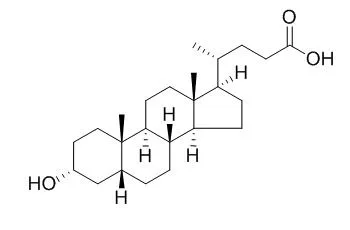| Description: |
Lithocholic acid is a toxic secondary bile acid, causes intrahepatic cholestasis, has tumor-promoting activity, its toxic effect can be protected after it activates the vitamin D receptor, PXR and FXR.Lithocholic acid is a vitamin D receptor (VDR) ligand, it can activate the VDR to block inflammatory signals in colon cells.
|
| In vitro: |
| Jpn J Cancer Res. 1998 Nov;89(11):1154-9. | | Lithocholic acid, a putative tumor promoter, inhibits mammalian DNA polymerase beta.[Pubmed: 9914784] | Lithocholic acid (LCA), one of the major components in secondary bile acids, promotes carcinogenesis in rat colon epithelial cells induced by N-methyl-N'-nitro-N-nitrosoguanidine (MNNG), which methylates DNA. Base-excision repair of DNA lesions caused by the DNA methylating agents requires DNA polymerase beta (pol beta).
METHODS AND RESULTS:
In the present study, we examined 17 kinds of bile acids with respect to inhibition of mammalian DNA polymerases in vitro. Among them, only LCA and its derivatives inhibited DNA polymerases, while other bile acids were not inhibitory. Among eukaryotic DNA polymerases alpha, beta, delta, epsilon, and gamma, pol beta was the most sensitive to inhibition by LCA. The inhibition mode of pol beta was non-competitive with respect to the DNA template-primer and was competitive with the substrate, dTTP, with the Ki value of 10 microM. Chemical structures at the C-7 and C-12 positions in the sterol skeleton are important for the inhibitory activity of LCA.
CONCLUSIONS:
This inhibition could contribute to the tumor-promoting activity of LCA. | | Ann Clin Biochem. 2009 Jan;46(Pt 1):44-9. | | Lithocholic acid as a biomarker of intrahepatic cholestasis of pregnancy during ursodeoxycholic acid treatment.[Pubmed: 19103957 ] | The diagnosis and treatment of intrahepatic cholestasis of pregnancy (ICP) has important implications on fetal health. The biochemical parameter commonly used in the diagnosis of ICP is the determination of the concentration of total serum bile acids (TSBA). However, bile acid profile, especially Lithocholic acid (LCA) analysis is a more sensitive and specific biomarker for differential diagnosis of this pathology and also could be an alternative to evaluate the efficiency of ursodeoxycholic acid (UDCA) for ICP treatment.
METHODS AND RESULTS:
Serum bile acid (SBA) profiles including LCA determination, were studied in 28 ICP patients using a capillary electrophoresis method. The effects of UDCA treatment on bile acid profile, were analysed in 23 out of 28 ICP patients and the two samples obtained before and 15 days after treatment were compared. Two samples taken as controls were also obtained from each of five patients without therapy.
A dramatic decrease in LCA concentrations and maintenance of TSBA concentrations were found in all patients after UDCA therapy, whereas SBA profiles together with LCA values did not change in patients without therapy.
CONCLUSIONS:
We propose LCA as an alternative biomarker and a more sensitive parameter than TSBA to evaluate the effectiveness of UDCA treatment, at least in ICP patients from Argentina. |
|






 Cell. 2018 Jan 11;172(1-2):249-261.e12. doi: 10.1016/j.cell.2017.12.019.IF=36.216(2019)
Cell. 2018 Jan 11;172(1-2):249-261.e12. doi: 10.1016/j.cell.2017.12.019.IF=36.216(2019) Cell Metab. 2020 Mar 3;31(3):534-548.e5. doi: 10.1016/j.cmet.2020.01.002.IF=22.415(2019)
Cell Metab. 2020 Mar 3;31(3):534-548.e5. doi: 10.1016/j.cmet.2020.01.002.IF=22.415(2019) Mol Cell. 2017 Nov 16;68(4):673-685.e6. doi: 10.1016/j.molcel.2017.10.022.IF=14.548(2019)
Mol Cell. 2017 Nov 16;68(4):673-685.e6. doi: 10.1016/j.molcel.2017.10.022.IF=14.548(2019)